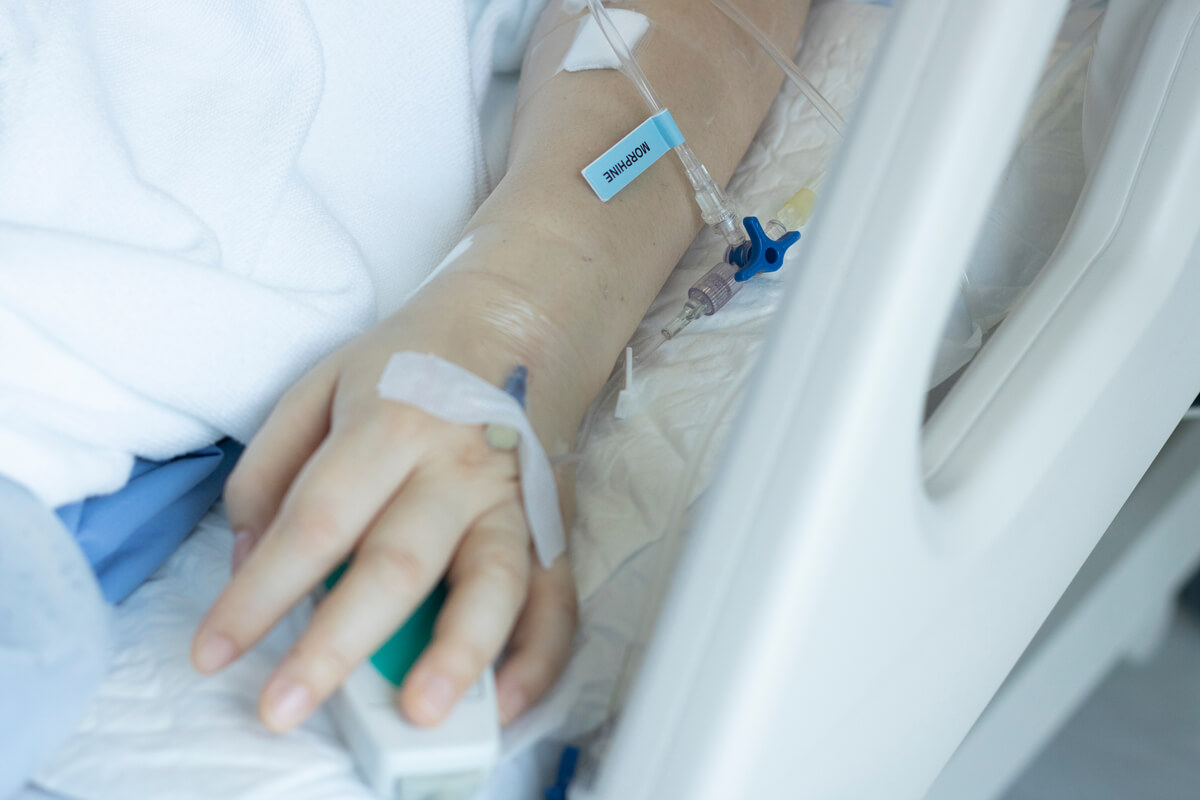The Treatment of Lyme Disease

Lyme disease is a disease transmitted by tick bites, which is very common in regions such as the United States and Europe. It appears as a result of infection by various bacteria belonging to the Borrelia genus. In this sense, the treatment of Lyme disease is aimed at eliminating the bacteria from the body.
Multiple studies demonstrate that oral antibiotic treatment is usually effective and represents the total cure of the disease in the early stages. However, the appearance of complications such as Lyme arthritis may indicate the presence of more resistant bacteria, and new therapeutic measures are needed.
Medicines to treat Lyme disease

The first option for treating Lyme disease will always be the use of antibiotics. The form of administration of the same can vary depending on the stage of the disease, being oral in the initial stages and intravenous when the disease has advanced.
At the same time, the use of other drugs such as non-steroidal anti-inflammatory drugs (NSAIDs) may also be necessary. They’re used to treat the symptoms of certain complications of the disease, such as Lyme arthritis.
In this sense, within the main prescriptions used for the treatment of Lyme disease, the following stand out:
Oral antibiotics
Oral antibiotics are prescribed for the treatment of Lyme disease when it’s in its initial stages and there haven’t been any complications. Several studies show that treatment with doxycycline 2 times a day for 10 or 21 days provides good results. Amoxicillin or azithromycin can also be used during these stages.
The mechanism of action of doxycycline and azithromycin are very similar. They inhibit protein synthesis in bacteria by binding to different parts of an organelle called the ribosome. At the same time, amoxicillin binds to a specific receptor on the plasma membrane of the bacterium, which induces its apoptosis (programmed cell death).
These medications must be used at precise doses and following the specialist’s instructions. This will help you get better results during treatment and reduce the chance of developing bacterial resistance. The use of antibiotics doesn’t usually have major side effects when done under medical supervision.
Some patients may experience a condition known as Lyme disease post-treatment syndrome after antimicrobial therapy is completed. It causes symptoms such as pain, confusion, and fatigue, which can last up to more than 6 months. Unfortunately, the cause of this syndrome is not known and there’s no specific treatment for it.
Intravenous antibiotics

The use of intravenous antibiotics is indicated as first-line treatment in some complications of Lyme disease. These guidelines were established by the National Institute for Health and Care Excellence in London and apply to central nervous system disease and heart disease with hemodynamic instability.
In these cases, in adults, the use of intravenous ceftriaxone at a dose of 2 grams daily for a maximum of 21 days is prescribed. Ceftriaxone works in a similar way to amoxicillin, in the sense that it binds to specific receptors found on the bacterial cell wall.
These drugs are also recommended as a second or third line of therapy for other complications such as Lyme arthritis, myocarditis, and chronic atrophic acrodermatitis. In this case, the recommended antibiotic will also be ceftriaxone at similar doses for 21 or 28 days, depending on the condition.
Intravenous administration increases the amount of medicine that’s capable of producing the desired effect, so its action will be more powerful. However, it also increases the likelihood of some side effects such as diarrhea, abdominal pain, rash, chest pain, or bloody stools.
Some of the side effects may be indicative of a severe condition, so your doctor should be notified of their occurrence. Intravenous ceftriaxone should only be used in a hospital environment and under the strict supervision of healthcare personnel.
Non-steroidal anti-inflammatory drugs (NSAIDs)
In addition to the use of doxycycline, amoxicillin, or ceftriaxone to eliminate the bacteria from the body, other drugs can also be used to alleviate the complications of the disease. Therefore, the use of NSAIDs may be beneficial in relieving pain and inflammation in Lyme arthritis.
These medications, such as ibuprofen or naproxen, are usually over-the-counter and can be taken during antibiotic treatment. They generate few side effects, although in this case, the treating doctor should be consulted about the safety of their consumption.
Alternative medicine for Lyme disease
The combination of some plant extracts has been shown to have an effect against the replication of Borrelia burgdorferi and other bacteria.
Some in vitro studies have shown that the combination of Samento and Banderol has an anti-inflammatory and antimicrobial effect. So, in the future, they could be an alternative to antibiotics for the treatment of Lyme disease.
However, it’s important to note that more research is needed to demonstrate the effect that these plants have on the human body. Therefore, traditional antibiotics remain the only approved and recommended therapeutic option.
A simple treatment with a high probability of cure
The main available treatment for Lyme disease is oral antibiotics, especially when the disease is in the early stages. The use of intravenous compounds is reserved for certain complications and when oral therapy doesn’t produce the desired effect.
Fortunately, treatment with oral antibiotics represents a total cure for the disease and its complications in most cases. It’s important to note that early diagnosis plays a fundamental role, so you should see a doctor immediately if abnormal symptoms occur after a tick bite.
Lyme disease is a disease transmitted by tick bites, which is very common in regions such as the United States and Europe. It appears as a result of infection by various bacteria belonging to the Borrelia genus. In this sense, the treatment of Lyme disease is aimed at eliminating the bacteria from the body.
Multiple studies demonstrate that oral antibiotic treatment is usually effective and represents the total cure of the disease in the early stages. However, the appearance of complications such as Lyme arthritis may indicate the presence of more resistant bacteria, and new therapeutic measures are needed.
Medicines to treat Lyme disease

The first option for treating Lyme disease will always be the use of antibiotics. The form of administration of the same can vary depending on the stage of the disease, being oral in the initial stages and intravenous when the disease has advanced.
At the same time, the use of other drugs such as non-steroidal anti-inflammatory drugs (NSAIDs) may also be necessary. They’re used to treat the symptoms of certain complications of the disease, such as Lyme arthritis.
In this sense, within the main prescriptions used for the treatment of Lyme disease, the following stand out:
Oral antibiotics
Oral antibiotics are prescribed for the treatment of Lyme disease when it’s in its initial stages and there haven’t been any complications. Several studies show that treatment with doxycycline 2 times a day for 10 or 21 days provides good results. Amoxicillin or azithromycin can also be used during these stages.
The mechanism of action of doxycycline and azithromycin are very similar. They inhibit protein synthesis in bacteria by binding to different parts of an organelle called the ribosome. At the same time, amoxicillin binds to a specific receptor on the plasma membrane of the bacterium, which induces its apoptosis (programmed cell death).
These medications must be used at precise doses and following the specialist’s instructions. This will help you get better results during treatment and reduce the chance of developing bacterial resistance. The use of antibiotics doesn’t usually have major side effects when done under medical supervision.
Some patients may experience a condition known as Lyme disease post-treatment syndrome after antimicrobial therapy is completed. It causes symptoms such as pain, confusion, and fatigue, which can last up to more than 6 months. Unfortunately, the cause of this syndrome is not known and there’s no specific treatment for it.
Intravenous antibiotics

The use of intravenous antibiotics is indicated as first-line treatment in some complications of Lyme disease. These guidelines were established by the National Institute for Health and Care Excellence in London and apply to central nervous system disease and heart disease with hemodynamic instability.
In these cases, in adults, the use of intravenous ceftriaxone at a dose of 2 grams daily for a maximum of 21 days is prescribed. Ceftriaxone works in a similar way to amoxicillin, in the sense that it binds to specific receptors found on the bacterial cell wall.
These drugs are also recommended as a second or third line of therapy for other complications such as Lyme arthritis, myocarditis, and chronic atrophic acrodermatitis. In this case, the recommended antibiotic will also be ceftriaxone at similar doses for 21 or 28 days, depending on the condition.
Intravenous administration increases the amount of medicine that’s capable of producing the desired effect, so its action will be more powerful. However, it also increases the likelihood of some side effects such as diarrhea, abdominal pain, rash, chest pain, or bloody stools.
Some of the side effects may be indicative of a severe condition, so your doctor should be notified of their occurrence. Intravenous ceftriaxone should only be used in a hospital environment and under the strict supervision of healthcare personnel.
Non-steroidal anti-inflammatory drugs (NSAIDs)
In addition to the use of doxycycline, amoxicillin, or ceftriaxone to eliminate the bacteria from the body, other drugs can also be used to alleviate the complications of the disease. Therefore, the use of NSAIDs may be beneficial in relieving pain and inflammation in Lyme arthritis.
These medications, such as ibuprofen or naproxen, are usually over-the-counter and can be taken during antibiotic treatment. They generate few side effects, although in this case, the treating doctor should be consulted about the safety of their consumption.
Alternative medicine for Lyme disease
The combination of some plant extracts has been shown to have an effect against the replication of Borrelia burgdorferi and other bacteria.
Some in vitro studies have shown that the combination of Samento and Banderol has an anti-inflammatory and antimicrobial effect. So, in the future, they could be an alternative to antibiotics for the treatment of Lyme disease.
However, it’s important to note that more research is needed to demonstrate the effect that these plants have on the human body. Therefore, traditional antibiotics remain the only approved and recommended therapeutic option.
A simple treatment with a high probability of cure
The main available treatment for Lyme disease is oral antibiotics, especially when the disease is in the early stages. The use of intravenous compounds is reserved for certain complications and when oral therapy doesn’t produce the desired effect.
Fortunately, treatment with oral antibiotics represents a total cure for the disease and its complications in most cases. It’s important to note that early diagnosis plays a fundamental role, so you should see a doctor immediately if abnormal symptoms occur after a tick bite.
- Chomel B. Lyme disease. Rev Sci Tech. 2015;34(2):569-76.
- Ross Russell AL, Dryden MS, Pinto AA, Lovett JK. Lyme disease: diagnosis and management. Pract Neurol. 2018;18(6):455-464.
- Schoen RT. Challenges in the Diagnosis and Treatment of Lyme Disease. Curr Rheumatol Rep. 2020;22(1):3.
- National Guideline Centre (UK). Lyme disease: diagnosis and management. London: National Institute for Health and Care Excellence (UK); 2018 Apr.
- Arvikar SL, Steere AC. Diagnosis and treatment of Lyme arthritis. Infect Dis Clin North Am. 2015 Jun;29(2):269-80.
- García Meléndez M, Skinner Taylor C, Salas Alanís J, Ocampo Candiani J. Enfermedad de Lyme: actualizaciones. Gaceta Médica de México. 2014;150:84-95.
Este texto se ofrece únicamente con propósitos informativos y no reemplaza la consulta con un profesional. Ante dudas, consulta a tu especialista.







